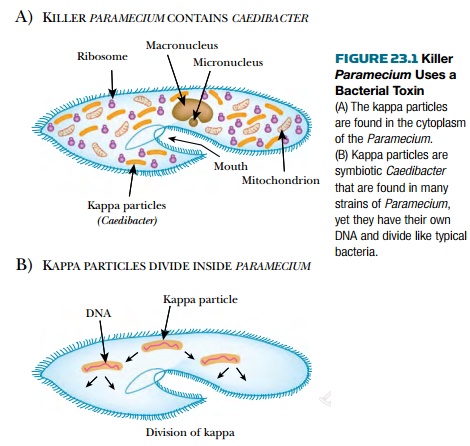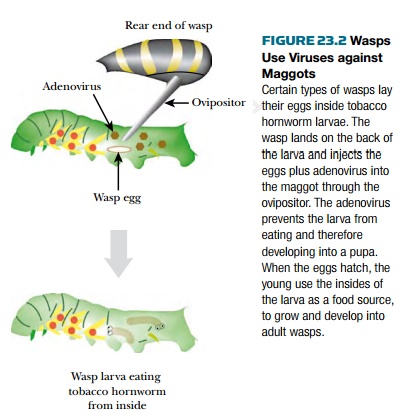Chapter: Biotechnology Applying the Genetic Revolution: Biowarfare and Bioterrorism
Germ Warfare among the Lower Eukaryotes
GERM
WARFARE AMONG THE LOWER EUKARYOTES
Paramecium is a well-known ciliated protozoan. Many strains of Paramecium
carry symbiotic bacteria ( Caedibacter ), known as kappa particles ,
that grow and divide inside the larger, eukaryotic, Paramecium cell (
Fig. 23.1 ). Those strains of Paramecium with kappa particles are known
as killers . Killing occurs when kappa particles are released by a killer and
eaten by a sensitive Paramecium (i.e., one lacking kappa particles).
Digestion of the kappa particle results in release of a protein toxin and death
of the sensitive Paramecium . Thus germ warfare is practiced by
single-celled eukaryotes.

The toxin gene is borne not on the
chromosome of the symbiotic bacteria, but on a bacterial plasmid derived from a
defective bacterial virus. So a toxin encoded by a virus infecting the kappa
particle bacteria has been diverted to the purpose of killing other strains of Paramecium
. This appears to be a general
principle. Many of the toxins used by pathogenic bacteria that infect humans
are actually encoded by DNA of nonchromosomal origin—viruses, plasmids, or
transposons. These elements are often integrated into the chromosome of pathogenic
strains of bacteria.
Some insects rely on viruses to wage
biological warfare. Certain parasitic wasps inject their eggs into plant-eating
maggots (i.e., the larvae of plant-eating insects). After the eggs hatch, the newborn
wasps eat the living maggots from inside. The maggots are eventually killed and
a new generation of wasps is released to continue their life cycle.

The secret to the wasp’s success is
injecting a virus along with their eggs ( Fig. 23.2 ). The virus, a member of
the adenovirus family, targets the maggot’s “fat body” (vaguely equivalent to
the liver of higher animals). The virus cripples both the maggot’s
developmental control system and its primitive immune system. The maggot loses
its appetite for plants and is prevented from molting and turning into a pupa,
the next stage on the way to an adult insect capable of laying more eggs. There
are many types of plant-eating maggots, including major agricultural pests such
as the tobacco budworm and cotton bollworm, and many types of wasps that attack
them, and consequently many types of viruses, each designed to soften up a
particular insect larva.
Related Topics